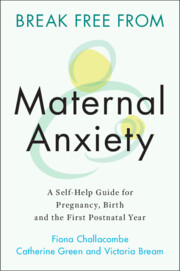 Break Free from Maternal Anxiety
Break Free from Maternal Anxiety Book contents
- Reviews
- Break Free from Maternal Anxiety
- Break Free from Maternal Anxiety
- Copyright page
- Dedication
- Contents
- About the Authors
- How to Use This Book
- Acknowledgements
- 1 Introduction
- 2 Persistent and Distressing Worry
- 3 Unwanted Intrusive Thoughts of Harm (Obsessive Compulsive Disorder)
- 4 Specific Phobias Affecting Pregnancy and the Postnatal Period
- 5 Panic Attacks and Health Worries
- 6 Feeling Anxious Around Other People
- 7 Coping with Traumatic Experiences While Pregnant and After Birth
- 8 Anxiety About Pregnancy and Birth
- 9 Anxiety and Adjusting to Motherhood
- 10 Beyond the Perinatal Period: Taking Your New Skills Forward into Parenthood
- Appendices
- References and Resources
- Selected Resources (A Complete List Can Be Found Online)
- Index
1 - Introduction
Published online by Cambridge University Press: 13 October 2022
- Reviews
- Break Free from Maternal Anxiety
- Break Free from Maternal Anxiety
- Copyright page
- Dedication
- Contents
- About the Authors
- How to Use This Book
- Acknowledgements
- 1 Introduction
- 2 Persistent and Distressing Worry
- 3 Unwanted Intrusive Thoughts of Harm (Obsessive Compulsive Disorder)
- 4 Specific Phobias Affecting Pregnancy and the Postnatal Period
- 5 Panic Attacks and Health Worries
- 6 Feeling Anxious Around Other People
- 7 Coping with Traumatic Experiences While Pregnant and After Birth
- 8 Anxiety About Pregnancy and Birth
- 9 Anxiety and Adjusting to Motherhood
- 10 Beyond the Perinatal Period: Taking Your New Skills Forward into Parenthood
- Appendices
- References and Resources
- Selected Resources (A Complete List Can Be Found Online)
- Index
Summary
This chapter provides an overview of what anxiety problems are, and why the perinatal period features all the key ingredients that can lead to problemmatic anxiety. Nurturing and caring for a baby is not easy for anyone and involves large emotional and physical demands, managing uncertainty and avoiding harm. All in the context of disturbed sleep and a major life change. The cognitive-behavioural model of anxiety states that it is not just the situation we find ourselves in, but the particular meaning we give to our experiences that drive and make sense of our emotions and other responses. In pregnancy and the postnatal period these meanings may be influenced by a complicated and sometimes traumatic journey to pregnancy and birth, beliefs about the importance of thoughts or physical sensations, and how we respond to the responsibility of being pregnant or in charge of a baby, as well as other personal and historical factors. There are many common factors across anxiety problems. In the rest of the book we explain how to apply this basic understanding to overcome particular forms of maternal anxiety.
- Type
- Chapter
- Information
- Break Free from Maternal AnxietyA Self-Help Guide for Pregnancy, Birth and the First Postnatal Year, pp. 1 - 16Publisher: Cambridge University PressPrint publication year: 2022


